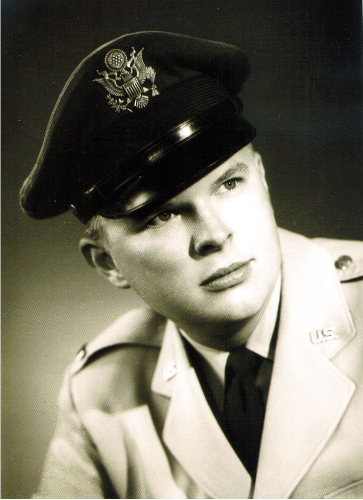In June 1957, I received a BS in chemical engineering from the University of Iowa, and was commissioned from Air Force ROTC as a Category II (engineering and scientific) Cadet. In August, I was called to active duty as an ammunition officer, with no further training, reported to the Ogden Air Materiel Area (OOAMA) at Hill AFB, Utah, where I was assigned to the 25th Ammunition Supply Squadron.
The West Area of Hill AFB was the former Ogden Arsenal, which the Air Force acquired from the Army in 1955, and which contained an extensive ammunition storage area and thirty industrial buildings. Consequently, the Directorate of Airmunitions at OOAMA was responsible for non-nuclear munitions for the Air Force, and 25th Ammo was the operational squadron. The Squadron included a Test Branch, which was just being activated and conducted tests on munitions. The smaller nondestructive, static firing, and explosive tests were conducted in the West Area at Hill, and the larger tests were conducted on the bombing range adjacent to the Bonneville Salt Flats at Wendover AFS, Utah, where the atomic bomb crews had trained in WWII.
I was assigned as assistant chief and project officer in the Test Branch. Other project officers were newly commissioned engineers and chemists.
Six of the more interesting tests were:
The Hughes Falcon was an air-to air missile powered by a rocket motor weighing about 30 pounds. The Air Force had many Falcon in inventory with motors which had exceeded their shelf life and could not be fired. We random sampled the inventory, conditioned at various temperatures, and static fired them. We determined that the Falcons could be fired safely in gunnery practice if fighters limited their time at high altitude and the rockets did not get too cold. Using the overage Falcons saved the Air Force millions of dollars.
A RB-57 dropped a M120A1 photoflash bomb with a M146A1 mechanical time fuse, which exploded prematurely endangering the airplane. We performed vibration tests on the fuse and found that at certain frequencies the timing would vibrate loose and change settings. A simple method of locking the timing ring solved the problem.
The 16NS1000 JATO, which was a solid propellant rocket, was used on a number of different aircraft to assist during take off. A fully loaded B-47 at Wheelus AFB in Libya was taking off when a JATO exploded and the plane crashed. Needless to say, the Strategic Air Command was not pleased. SAC shipped a random sample of 1200 JATOs from all over the world to us. We inspected and static fired the JATOs 18 hours a day, and when the firings were normal, released them lot by lot for SAC’s use. During the test firings, I received a telephone call from Colonel Nelson Miles, the Director of Airmunitions, who asked, “Lieutenant, what is the status of the tests?” I said, “Sir, may I call you back as we are in the middle of a firing?” He replied, “No. General Anderson is talking with General LeMay, and they want an answer now.” The test firing was immediately stopped! We determined that if the JATOs were stored in igloos at too high a temperature, some of the propellant migrated into the firing tube resulting in excess pressure when fired which caused a rupture of the casing. Limiting the storage temperature solved the problem.
The Snark SM-62 was an intercontinental, thermonuclear-armed guided missile. It was launched by two large 65, 000 pound thrust solid propellant rockets until the turbojet took over the propulsion. We performed the hazard classification test on the Snark at Wendover to determine safety requirements for transportation, storage and launch. The test was a detonation of the conventional explosive trigger for the nuclear warhead to see the impact on the two solid rockets. The result of the test was that the explosion ignited the rockets, which destroyed the test stand. Only one squadron of Snarks was eventually deployed in Maine, because the air breathing guided missiles were eclipsed by ballistic missiles.
The BOMARC IM-99B was a ground to air pilot-less nuclear interceptor aircraft. To launch the missile, a 50,000 pound thrust solid propellant rocket was fired until the two ramjets started. We conducted hazard classification tests on the BOMARC at Wendover by detonating a simulated conventional trigger for the nuclear warhead to determine what would happen to the large solid rocket. The outcome was an explosion of the rocket. The program was curtailed after eight squadrons were deployed, because of the threat of ballistic missiles rather than manned bombers.
Hercules was developing the solid propellant rocket for the third stage of the Minuteman I intercontinental ballistic missile at its Utah facility. Hercules approached us to static fire the first prototype rocket motor at our Wendover test site, because they were concerned that it would detonate and destroy their expensive, sophisticated test stand. We static fired the first third stage, which resulted in a high order detonation leveling our relatively unsophisticated and inexpensive test stand, which saved tens of thousands of dollars
I have bright memories of my tour at Hill AFB. At an early age, I had management and leadership experiences, which I would not have had for years in industry. We made fast friendships, which have survived for over half a century. And we did valuable work for the Air Force.
After completing my tour of duty in 1960, I enrolled in Harvard Business School and received the MBA. I spent 27 years in general management in international business in Australia and the United Kingdom as the number two officer in a “Fortune 1000” corporation, and as president and co-owner of Wall-Lenk Corporation in Kinston. After retiring from business, I became the Assistant Dean for Graduate Programs in the College of Business at East Carolina University.
November 2011

